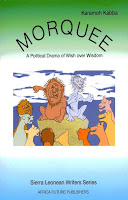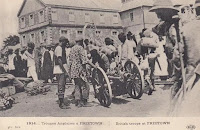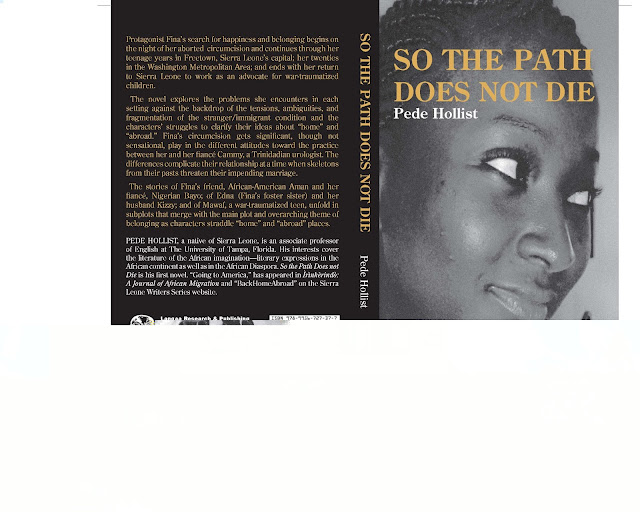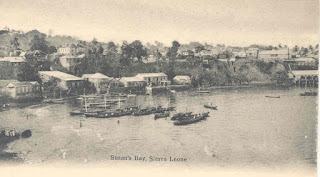Morquee: Chapter Two
Morquee: Chapter Two
by Karamoh Kabba, excerpted from Morquee
Gbankaya is the headquarters town of Gbankaya Chiefdom. It is the largest Chiefdom with the biggest towns in Kono District. The town had not changed much from the time Morquee left it in the early sixties. The road network into Gbankaya and in the township was the same. As a boy growing up there, he first saw these road projects as a white man's benevolence to help the natives. But after he studied the history of colonialism, he had developed a different view about the intention of the colonial masters when they constructed road networks into the provinces. It was more to facilitate cash crop transportation to the capital city for export. Even the popular railway that wound through resource-rich provinces seemed like a straw stuck into a ripe orange fruit with England at the receiving end sucking hard, dehydrating the fruit right to its stem and not putting nutrients back into the soil. There had been no change to the road network, but the railway was no more in operation. In Gbankaya, the two main roads across Newtown and Old town remained the same. They went their separate ways at the northern edge of the town at a fork on the main road from Sefadu, the district headquarters of Kono, and met again where the main road continued to Kailhun District and beyond at the southern edge.
Along the Newtown and Old town roads were rows of family houses. They faced each other on both sides of the road. Two miles up and down several hills along Old town Road, was the chief's compound on the promontory of the highest peak. The Gbankayaians built the chief's compound on this high peak as a defensive strategy against invaders during wars of conquest. Oral tradition has it that Gbankaya was never conquered in wars of the old days because of its location, and that Gbankayaian fighters routed their enemies before they approached the King's palace. That was before the colonial masters broke Gbankaya Kingdom into chiefdoms using a divide-and-rule strategy to control the people. Farther away beneath a couplet of hills was a vast plain, which was home to the primary school.
Behind the rows of houses, were small rice barns or houses, which together made compounds. The people identified the compounds by family names: Morquee Compound; Lebbie Compound; Ngegba Compound and so on. Behind the compounds were shrubs of coffee and cacao plants and a variety of fruit-trees, which often indicate family plantation farms. From the fruit trees, branches crept onto the rooftops of the barns and small houses. Often packs of monkeys took advantage of the quiet time during the days to ravage the orchards. They hooted, squealed and squeaked as they hurled oranges, mangoes and bananas at each other, disturbing the daytime quietness. At sounds of approaching humans or at dusk, before the people returned home from their farms, the monkeys disappeared into the surrounding forest.
Trails ran behind the compounds that linked the footpaths to the farms. Members of the hardworking farming community followed the trails to their farms every morning before the first cockcrows. Unless one had a deliberation at the courthouse or belonged to the Council of Elders that presided over court cases, the town was often empty from the early hours of dawn to lat dusk.
Cacao and coffee plantation forest festooned the big circle of land in the middle of the township. Across this forest were trails originating at two-block intervals. The trails formed an intricate network of paths that led to the only ground water source. The paths led from Newtown to the right or from Old town to the left and vice-versa. Dangerous reptiles filled the vast forest in the middle of the town.
Morqee had taken one of these trails morning and afternoon, Monday through Friday for seven years when he attended the United Methodist Primary School on the other side of Newtown. The trail to the primary school was dangerous. Although the schoolchildren walked around Newtown Road or Old town Road to school, they chose this dangerous path because it was about half the distance, a straight line across the shortest distance.
He recalled when a snake bit a boy along this trail on their way home from school. It was a heart-wrenching day for the whole community. The tropical sun was sweltering hot that afternoon. Almost everyday, Morquee and many more students played in the cacao forest on their way home from school.
In the morning, they hastened to school to avoid being flogged for tardiness. Halfway home, just after the coffee plantation, was a vast rice swamp. The cacao plantation starts across the rice swamp, along its northwestern edge. The other half of the narrow path home bound twisted and turned beneath cacao trees to the other side of Newtown, to Morquee compound and the other compounds along Newtown Road. In the dry season, beautiful spreads of yellow, green, brown and red cacao leaves formed beneath the trees. The dry season leaves and piercing tropical sun rays that filtered through the openings of the cacao tree's canopy formed pretty shadows beneath the forest. Invariably, the defoliation process consumed the undergrowth and formed a colourful spread on the forest floor all year round.
For Morqee and the other children of Gbankaya, regardless of the eminent danger in the cacao forest, it was time to play whenever they arrived in this fun place. When it was sweltering hot in the serpent-infested cacao forest, like on that dreadful day, cobras, mambas, pythons and more dangerous reptiles were active.
...There were also good memories of growing up in Gbankaya. Two miles down the path behind Morquee Compound, halfway to the Morquee family cacao plantation, is Tombguay River. Each day, after-school, Morquee, adorned in farm attire, followed the path to the farm. At Tombguay, he met many other children of Gbankaya before they went on their separate directions to the different farms. The river was another fun destination for the children of Gbankaya.. Rumour spread that crocodiles lived a few hundred yards upstream. The children were always warned against swimming in the river without adult supervision.
The adults' warning became a butt for the children's joke that
“The elders created the crocodile fable to keep us off the river.”
Always, it was to no avail. The children cooled off in Tombguay everyday, for about an hour or so, before they proceeded to meet their parents on the farms. They dived in the deepest sections of the river from overhanging boulders along the riverbank. On the riverbed were more boulders with jagged edges resulting from erosion caused by boulders colliding against each other. Children often came out of the river with severe head injuries. Many a time, Morquees grandfather flogged him when he detected that he had been swimming and diving. To clear his red eye, Morquee, like the rest of the children, squeezed liquid from a succulent, tropical plant before he departed from the river.
Karamoh Kabba is a native of Peyima, Kamara Chiefdom, Kono District, Sierra Leone. Other works by the author include A Mother's Saga: An Account of the Rebel War in Sierra Leone, and Lion Mountain: A Perilous Evolution of the Dens. He has also published several poems, including “Poverty amidst Gold and Diamonds” in With Hearts Ablaze an anthology of the International Library of Poetry.
Excerpted from Morquee by Karamoh Kaaba. Copyright © 2005 by Karamoh Kabba. Reprinted with permission by Sierra Leone Writers Series




Comments
Post a Comment